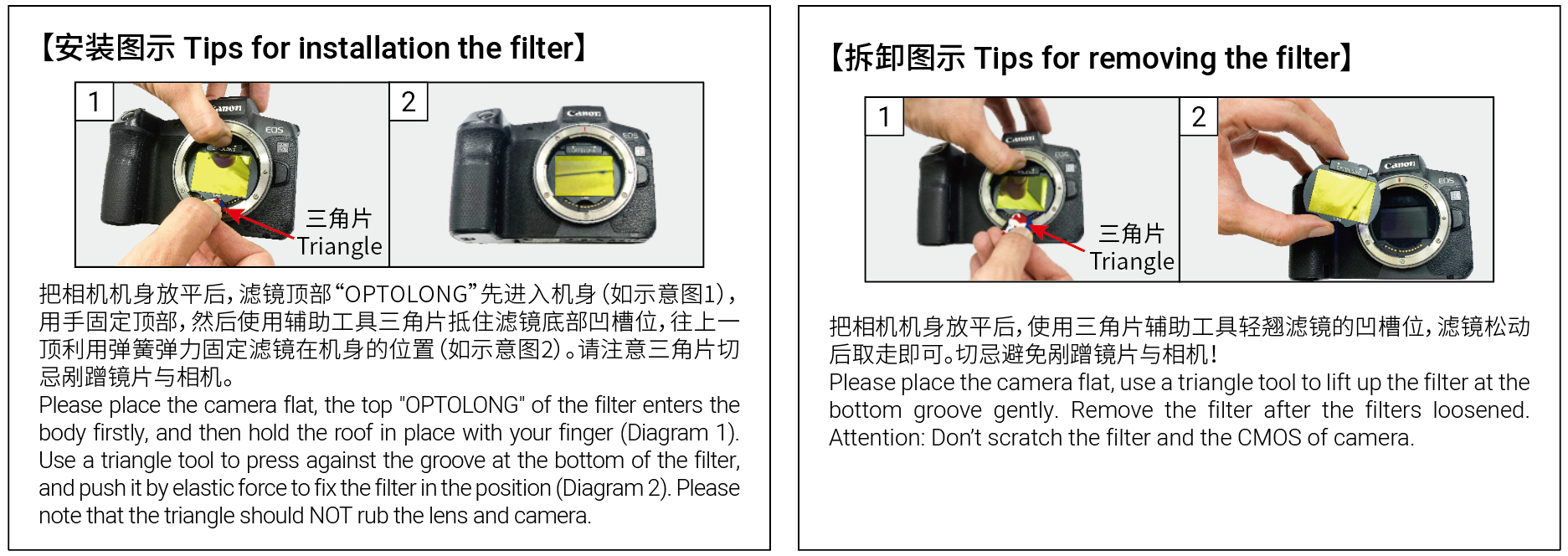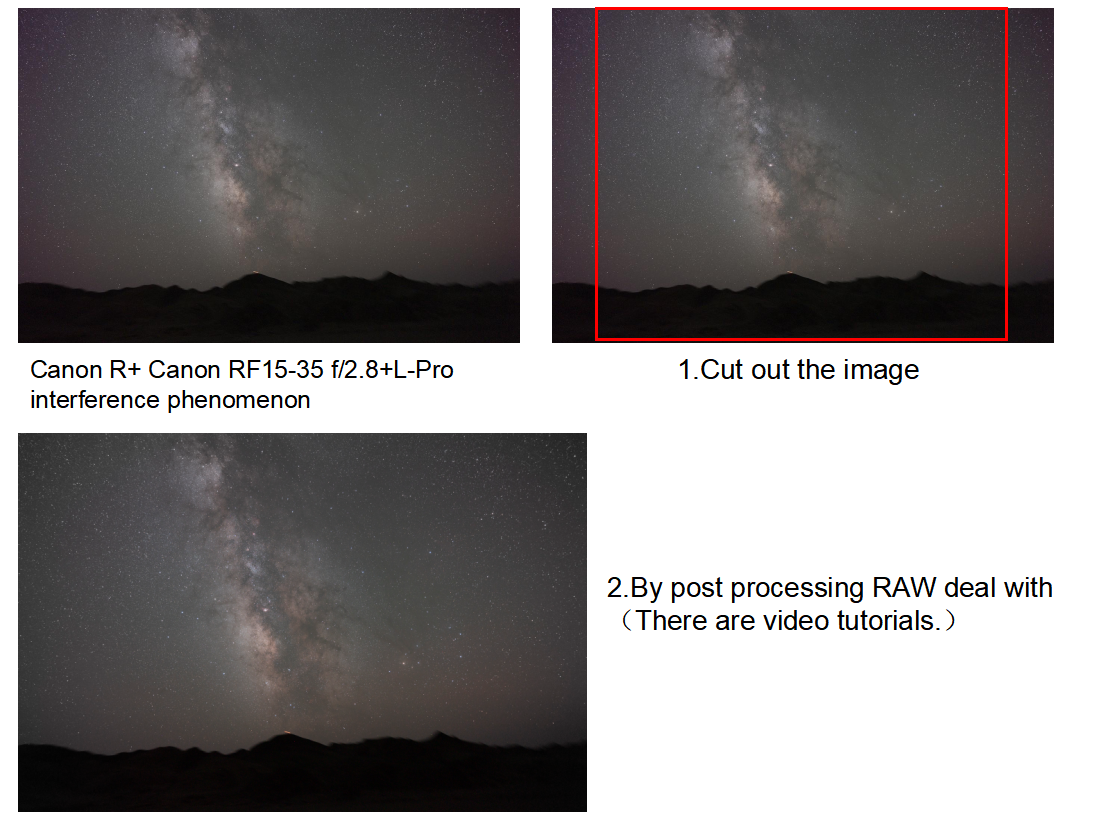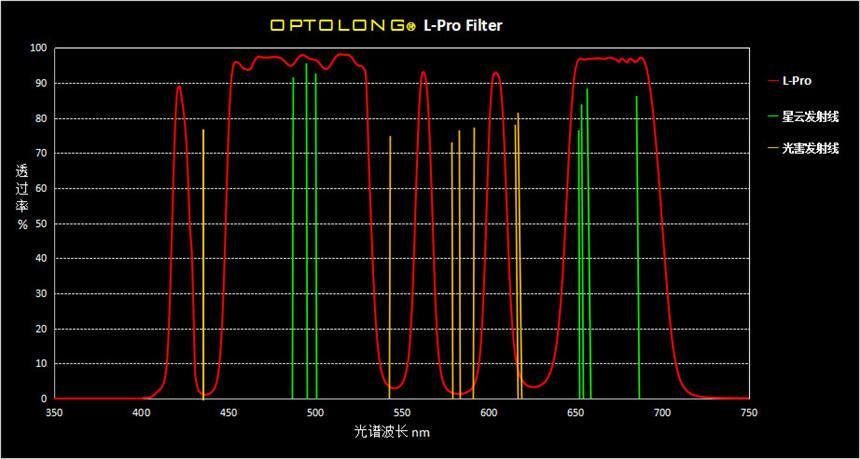In suburban areas with weak light pollution, the color balance is good. The design of multi-band pass ensures excellent color restoration. L-Pro is a low color cast filter, which specially designed for starry sky photography. That is not possible with other light pollution filters
Optolong L-Pro (L-Professional) filter is designed to improve the visibility of various deepsky objects. By selectively reducing the transmission of wavelengths of light pollutants, specifically those produced by artificial lightings including mercury vapor lamps, both high & low pressure sodium vapor lights and the unwanted natural light caused by neutral oxygen emission in our atmosphere (i.e. skyglow). Together with the highly transparent in main nebula emission lines at OIII(496nm and 500nm), H-beta (486nm), NII(654nm and 658nm), H-alpha(656nm) as well as SII(672nm), the filter is suitable for enhancing the contrast and details for both visual and photograghic purpose at sub-rural area with heavy light pollution.
Unlike other light pollution filter UHC and CLS, L-Pro is multi-bandpass filter which offers better color balance by maximizing the transmission band. The balanced transmission allows astrophotos to be taken with minimal color cast to broadband emission objects such as galaxies, reflection nebulae and globular star clusters. L-Pro is the best choice for light pollution suppression.
Main Use and Performance
Suitable for visual observation and astrophotography.
L-Pro filter has a very low transmission reduction rate against continuous spectrum space objects, and thus is quite effective in suppressing light pollution sources when shooting galaxies, reflection nebulae and globular star clusters. The same holds true for visual star observations.
L-Pro filter alone can suppress infrared wavelength, and thus can be used at ease for “L” image shootings with CCDs.Light pollution filter do not eliminate the effects of light pollution or increase the object’s brightness. In many cases, they increase the contrast between nebula and night sky, not brightening the nebula.
WARNING: The filters of Optolong are not designed for sun observation. DO NOT LOOK AT THE SUN WITH OPTOLONG FILTER. You would be BLIND if you fail to observe the warning.
| L-Pro EOS-R Compatible Cameras and Lens |
| Applicable camera body | EOS R/Ra、EOS RP、EOS R5、EOS R6 |
| Applicable Lenses | Full range of RF main and auxiliary lens Full range of EF main and auxiliary lens (adapter is required) |
L-Pro EOS-R Compatible Cameras and Lens
| L-Pro EOS-R Compatible Cameras and Lens |
| Applicable camera body | EOS R/Ra、EOS RP、EOS R5、EOS R6 |
| Applicable Lenses | Full range of RF main and auxiliary lens Full range of EF main and auxiliary lens (adapter is required) |
Tips:Due to limit lens resource, we only test the popular lens in market. If any available lens, feel free to contact Optolong customer service staff. We appreicate for your valuab testing information.
Installation and Removing Instructions

1.4 EOS-R L-Pro Clip More Explanation
Due to the particularity of Canon R series micro-single optical path, aperture design and light incident Angle, slight dark angle interference will occur when using interference filter for imaging.
There are two solutions to solve peripheral interference phenomenon:
1>Cut out the interference areas of pictures.
2>By post processing via RAW (attach video tutorials).

Final version the Milkway by EOS R L-Pro.
Canon R+Canon RF15-35 f/2.8+L-Pro clip Image came from domestic astrophotographer ©拂晓_718

L-Pro Spectrum and Characteristic
According to the relatively light pollution in suburbs, the image does not produce obvious color deviation phenomenon. The multi-band spectrum is specially designed and optimized as shown in the figure below.
Peak transmittance: T>90%
Blocking range: 380nm-750nm
Blcoking depth: light pollution line blocking >90%
Surface quality: 60/40(Refer to MIL-O-13830)
Transmitted Wavefront RMS: λ/4
Parallelism: 30s

How to read the chart?
▲The horizontal axis is the Wavelength in Nanometers(nm).
▲The vertical axis is transmission in %.
▲The RED line shows the transmission line of L-Pro filter. The artifical emission lines are shown in ORANGE. And the emission lines from constellation are shown in GREEN.

Coating Technology
·Multi-layers anti-reflection coating
·Non-cementing optical substrate coating
·Optolong L-Pro filter adopts precision coating based on Ion-assisted deposition coating technology for durability and resistance to scratching, as well as stability on CWL(central wavelength) no deviation affected by temperature change.
·Planetary rotation system offers precision and homogeneity of coatings ensuring high value on transmission of pass-band and Optical density of off-band.



















 Fast & Reliable Delivery
Fast & Reliable Delivery Helpful & Friendly Staff
Helpful & Friendly Staff Best Prices Online
Best Prices Online 100% Secure Shopping
100% Secure Shopping